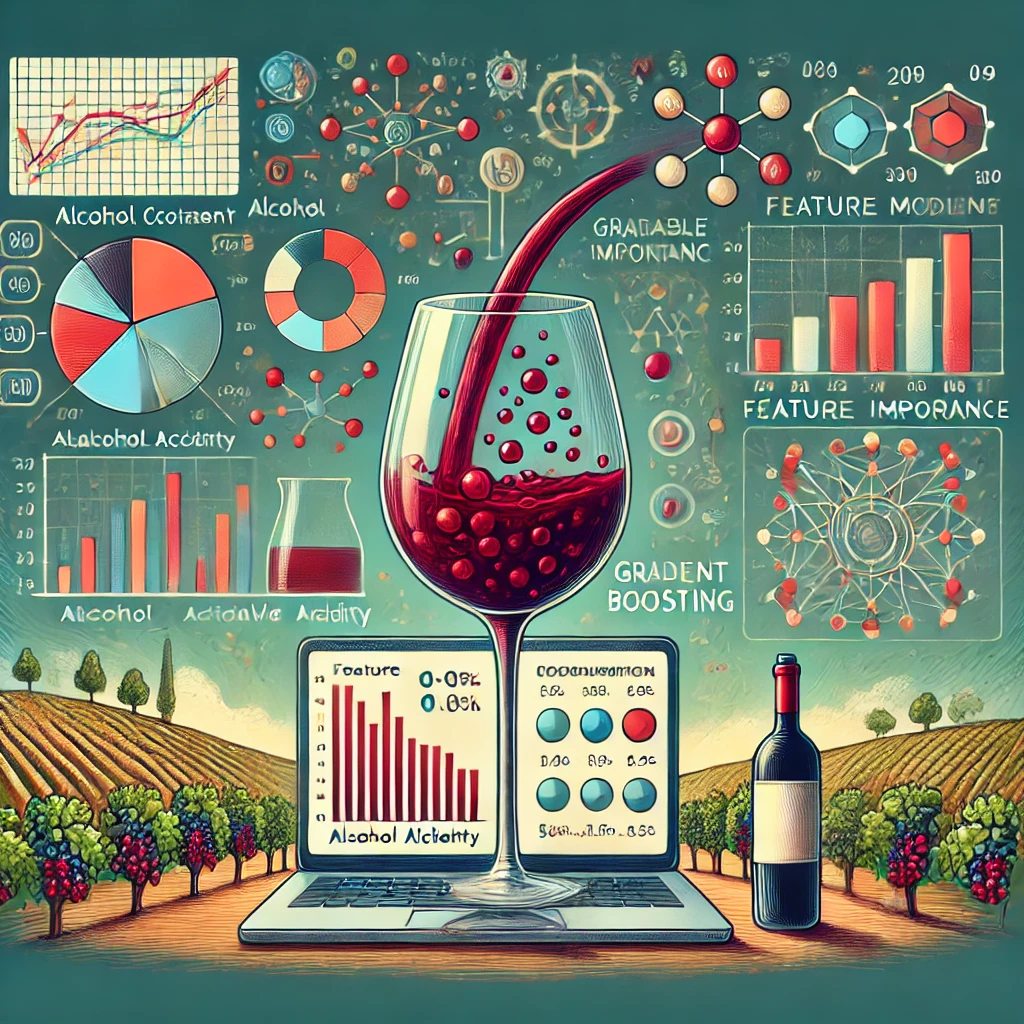Red Wine Quality Prediction: Machine Learning Model
 Mohd Athar Shoyeb
Mohd Athar Shoyeb
In the world of wine, quality is everything. From the vine to the glass, countless factors influence the final product. For both producers and consumers, understanding these factors and how they relate to wine quality is crucial. This blog post delves into a machine learning project that aims to predict the quality of red wine based on various physicochemical properties.
Using a dataset of red wines from Portugal's "Vinho Verde" region, we explore how to build a classification model that accurately predicts whether a wine is of good quality. This project is a fascinating blend of data science and enology, providing insights into both the technical aspects of machine learning and the subtleties of wine production.
The Dataset
The dataset used in this project comes from the UCI Machine Learning Repository and contains information about red and white variants of the "Vinho Verde" wine. However, for this project, we focus exclusively on the red wine data. The dataset includes 11 physicochemical variables, such as acidity, residual sugar, and alcohol content, along with a quality score given by wine experts.
The features in the dataset are:
Fixed Acidity: The concentration of fixed acids, which contributes to the wine's tartness.
Volatile Acidity: The concentration of volatile acids, often associated with spoilage.
Citric Acid: Contributes to the freshness and flavor of the wine.
Residual Sugar: The amount of sugar left after fermentation, which can influence sweetness.
Chlorides: The concentration of salt, which can affect the wine's overall flavor.
Free Sulfur Dioxide: Protects wine from oxidation and microbial growth.
Total Sulfur Dioxide: The total amount of sulfur dioxide present, including bound and free forms.
Density: Influences the wine's body and mouthfeel.
pH: A measure of the wine's acidity.
Sulphates: A wine preservative that also enhances flavor.
Alcohol: The percentage of alcohol, which can impact the wine's body and flavor.
The target variable is the quality score, which ranges from 0 to 10. For this project, we treat it as a binary classification problem, classifying wines as either "good" (quality score ≥ 7) or "not good" (quality score < 7).
Exploratory Data Analysis (EDA)
Before diving into model building, it's essential to understand the dataset through exploratory data analysis (EDA). EDA involves visualizing the data, identifying patterns, and uncovering any potential issues such as missing values or outliers.
Distribution of Quality Scores: The first step in EDA is to examine the distribution of quality scores. The majority of wines in the dataset have a quality score between 5 and 6, with very few wines rated as 8 or above. This imbalance is a key consideration when building the classification model.
Correlation Analysis: Next, we explore the relationships between the features and the target variable. Using a correlation matrix, we identify which features have the strongest correlations with wine quality. For instance, alcohol content and volatile acidity show significant correlations with quality, indicating that they are important predictors.
Data Preprocessing: Before feeding the data into a machine learning model, it's crucial to preprocess it. This involves handling missing values, scaling features, and addressing class imbalance. In this project, we use techniques such as standardization to ensure that all features contribute equally to the model.
Model Selection and Training
With the data preprocessed, the next step is to select and train a machine learning model. Given the binary nature of the classification problem, several algorithms are suitable, including Logistic Regression, Decision Trees, Random Forests, and Gradient Boosting.
Logistic Regression: This is a simple yet powerful algorithm for binary classification. It works well when there is a linear relationship between the features and the target variable. In this project, Logistic Regression serves as a baseline model.
Decision Trees: Decision Trees are intuitive and easy to interpret. They work by splitting the data into subsets based on the most significant feature at each node. However, they can be prone to overfitting, especially with noisy data.
Random Forests: A Random Forest is an ensemble method that combines multiple Decision Trees to improve accuracy and robustness. By averaging the predictions of individual trees, Random Forests reduce overfitting and perform well on a variety of datasets.
Gradient Boosting: Gradient Boosting is another ensemble method that builds models sequentially, with each new model correcting the errors of the previous one. It is highly effective but can be computationally expensive.
In this project, we train each of these models using the red wine dataset. We use cross-validation to assess their performance and select the best model based on metrics such as accuracy, precision, recall, and F1-score.
Addressing Class Imbalance
One of the key challenges in this project is the imbalance in the quality scores. With so few wines rated as "good," it's easy for a model to be biased toward predicting the majority class. To address this, we experiment with techniques such as oversampling the minority class and using balanced class weights.
Oversampling: Oversampling involves duplicating samples from the minority class to balance the dataset. While this can help improve model performance, it can also lead to overfitting.
Class Weights: Another approach is to assign higher weights to the minority class during model training. This encourages the model to pay more attention to the underrepresented class.
By experimenting with these techniques, we can build a more balanced model that performs well across both classes.
Hyperparameter Tuning
To further improve model performance, we perform hyperparameter tuning. This involves optimizing the parameters of the selected model to achieve the best possible results. For example, in the case of Random Forests, we might tune the number of trees, the maximum depth of each tree, and the minimum samples required to split a node.
We use grid search and cross-validation to systematically explore different combinations of hyperparameters. This process can be computationally intensive but is essential for squeezing the maximum performance out of the model.
Model Evaluation
After training and tuning the models, we evaluate their performance on a test set. The primary metrics used for evaluation are:
Accuracy: The percentage of correctly classified instances.
Precision: The percentage of true positives among all positive predictions.
Recall: The percentage of true positives among all actual positives.
F1-Score: The harmonic mean of precision and recall, providing a balanced measure of performance.
We also use the ROC-AUC score to assess the model's ability to distinguish between the two classes. A high AUC score indicates that the model is effective at predicting both "good" and "not good" wines.
In this project, the Gradient Boosting model achieves the best results, with an AUC score of 0.90. This suggests that the model is highly accurate in predicting wine quality based on the given features.
Feature Importance
Understanding which features are most important for predicting wine quality can provide valuable insights. In this project, we use techniques such as feature importance scores and SHAP (SHapley Additive exPlanations) values to interpret the model's decisions.
For instance, alcohol content, volatile acidity, and sulphates emerge as key predictors of wine quality. This aligns with our expectations, as these factors are known to influence the flavor, aroma, and overall perception of wine.
Conclusion
The Red Wine Quality Prediction project showcases the power of machine learning in uncovering patterns and making predictions based on complex data. By carefully preprocessing the data, selecting the right model, and tuning hyperparameters, we can build a model that accurately predicts wine quality.
This project not only highlights the technical aspects of data science but also offers practical insights into the factors that contribute to good wine. Whether you're a data scientist or a wine enthusiast, this project demonstrates how data can be used to enhance our understanding of the world around us.
As we continue to refine our models and explore new techniques, the possibilities for applying machine learning to other domains are endless. From wine to healthcare, finance, and beyond, the tools and methods used in this project have broad applications.
In the end, the Red Wine Quality Prediction project is more than just an exercise in machine learning—it's a journey into the art and science of wine, where data and tradition come together to create something truly special.
Subscribe to my newsletter
Read articles from Mohd Athar Shoyeb directly inside your inbox. Subscribe to the newsletter, and don't miss out.
Written by
